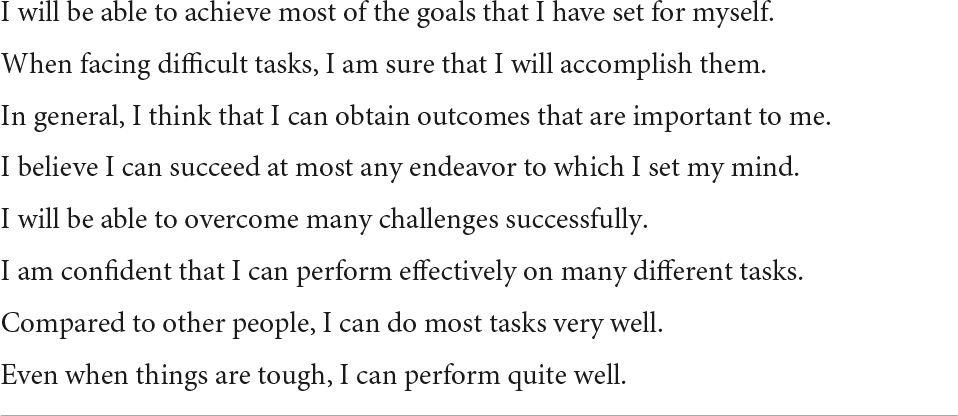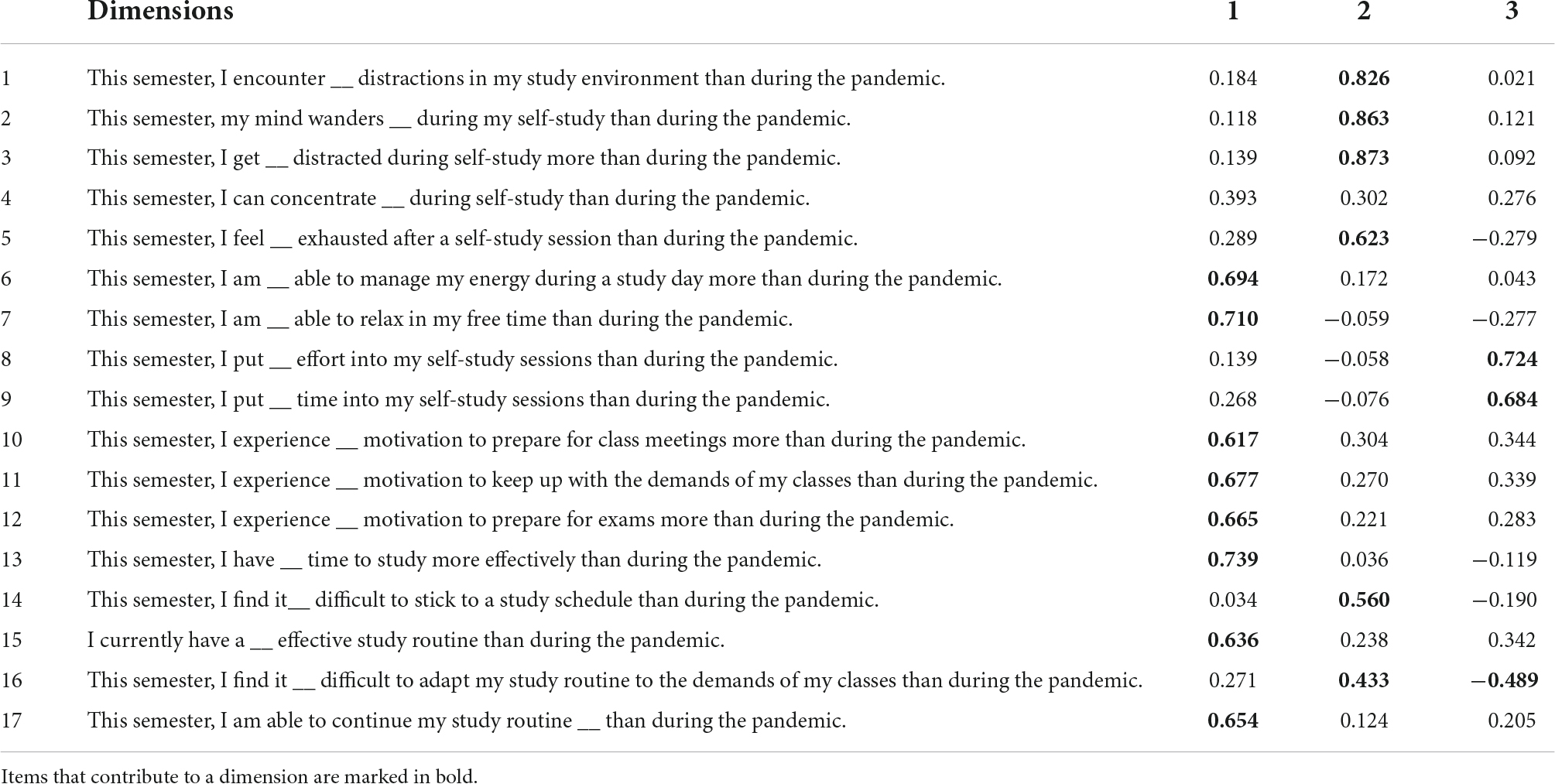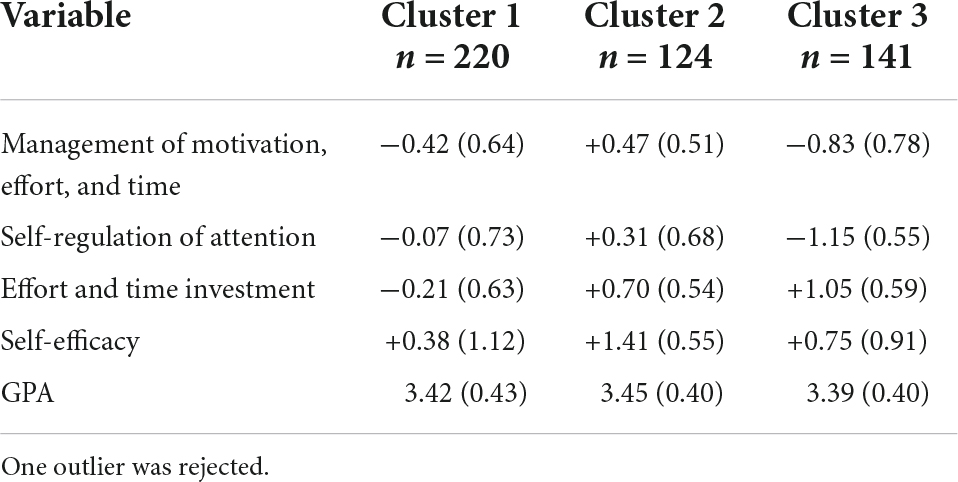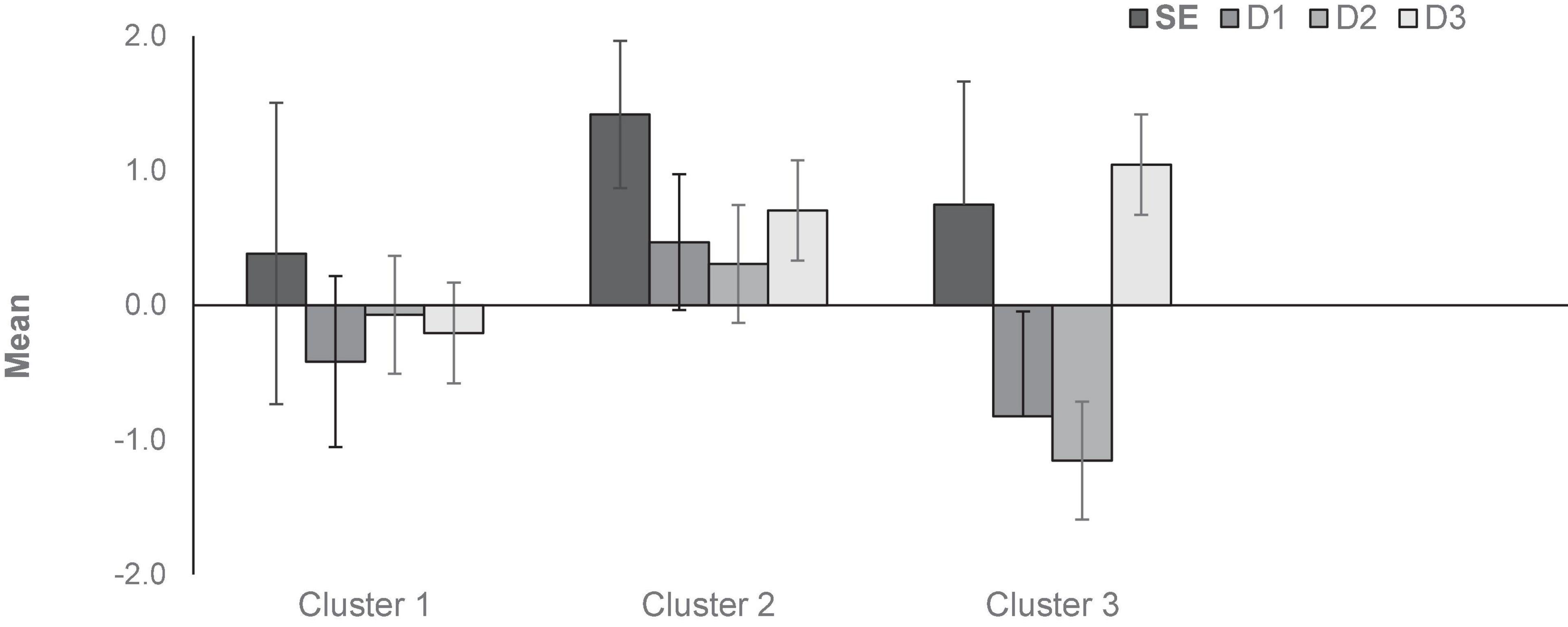- 1College of Sciences and Human Studies, Prince Mohammad Bin Fahd University, Al Khobar, Saudi Arabia
- 2College of Law, Prince Mohammad Bin Fahd University, Al Khobar, Saudi Arabia
- 3Department of Student Affairs, Prince Mohammad Bin Fahd University, Al Khobar, Saudi Arabia
The present research examined students’ responses to the post-pandemic instructional world. The participants were women of society transitioning from a patriarchal order to one fostering gender equity in education and employment. At the end of the first semester, which highlighted their return to campus, students completed a questionnaire on their self-efficacy and a questionnaire on their responses to the post-pandemic learning environment as compared to the pandemic one. Students’ self-management of motivation, effort, time, self-regulation of attention, and time and effort investment revealed three kinds of responses to change: adaptation, maintenance, and surrender. Responses varied with self-efficacy. These multidimensional patterns were interpreted to discover how best to provide support services in the post-pandemic ecosystem.
Introduction
The pandemic has highlighted the benefits of adaptability (Padmashree et al., 2022). As a result, people’s ability and determination to respond to environmental changes have become a valued commodity in a post-pandemic world. Differences in such responses have been uncovered, comprising a spectrum from individuals who resist change even if it is unavoidable and in their self-interests to those who embrace it reflexively. The extant literature has highlighted various sources of resistance to change, which have been organized into four key sources of people’s resistance: routine seeking (i.e., predilection for and comfort with established habits as well as preference for low environmental stimulation), emotional reactions to imposed change (i.e., low resilience and concern about losing control), short-term focus (i.e., attention to the ensuing inconvenience of dealing with change in the immediate aftermath of it rather than on its long-term outcomes), and cognitive rigidity (i.e., frequency and perceived ease of changing one’s mind; Oreg, 2003).
In contrast to the avalanche of research on sources, a few studies in the extant literature have focused on people’s responses to change during the pandemic, under the assumption that individual differences in such responses have had sizable consequences on performance and, more broadly, on their wellbeing (Gonzalez et al., 2020; Pilotti et al., 2022). Consider, for instance, college students’ responses to the changes brought about by online learning. Biwer et al. (2021) identified several dimensions of responses to change, including attentional regulation, effort regulation, time management, motivation, and effort and time investment. Then, through cluster analysis, the researchers classified students into four types of response patterns: adaptation, maintenance, surrender, and feeling overwhelmed. Adaptation pertained to students who did not resist change. Rather, they saw it as a set of opportunities, displaying an overall positive attitude. Fostering this attitude was an appreciation for the increased sense of autonomy that online learning demanded of them, which translated into students’ self-reported improved attentional regulation, effort regulation, time management, motivation, and investment of effort and time. The other students’ reactions exemplified different degrees and forms of resistance to change. For instance, the opposite reaction to adaptation was surrender, whereby students experienced an overall negative attitude and reported difficulties in attentional regulation, effort regulation, time management, motivation, and less investment of effort and time. The unifying theme of surrendering was the perception that the increased autonomy demanded by online learning was a liability. Similar but not identical to the surrender reaction was that of students who reported feeling overwhelmed. These students also experienced difficulties in attentional regulation, effort regulation, time management, and motivation. However, they attempted to counteract the disruptions allegedly brought about by online learning through a greater investment of effort and time. Maintenance referred to students’ rather muted reactions to online learning, thereby making it less negative than that of students who experienced surrender or felt overwhelmed. Such students also reported difficulties in attentional regulation, effort regulation, time management, and motivation, but to a lesser degree. Furthermore, they reported greater effort and time investment, but not as much as the students who felt overwhelmed.
The present study focused on the post-pandemic world. It asked how college students have responded to a return to face-to-face instruction. It rested on the observation that the post-pandemic world is not isomorphic to the pre-pandemic world. The online medium has more visibly seeped into the delivery of instruction through platforms that can not only store course materials but also allow for either real-time (synchronous) or delayed (asynchronous) human interactions. At the very least, the post-pandemic world is now an uneven mixture of mostly face-to-face instruction intermixed with sporadic adventures into the online medium propelled by necessities (e.g., sudden transportation issues, illnesses, etc.). For many, however, the online medium has become a viable alternative to in-person office hours. It has propelled instructors’ reliance on blended or hybrid instruction, which involves a mixture of in-person and online sessions, all accompanied by online resources and tasks. In the hybrid medium of instruction, the online components serve as substitutes for in-person class meetings, whereas in the blended medium, they are intended to enhance or add to the topics discussed in the classroom (Singh et al., 2021). Furthermore, in the hybrid medium, online interactions can be either synchronous (i.e., real-time meetings) or asynchronous (i.e., students access materials and participate in class discussions at different times).
Our study specifically targeted female college students in a society transitioning from a rigidly patriarchal system to one enforcing gender equity in education and employment. In such a society, of which Saudi Arabia is a prototype, women have recently experienced a whirlpool of changes, delivered through decrees, declarations, and financial investments, which include their ability to enter degree programs and professions of their choosing, greater agency, and freedom of movement (Saleh and Malibari, 2021). Women, especially female college students, have become one of the pillars of the transition from an oil-based economy to one that is knowledge- and service-based, which is, at its core, diversified and integrated into the global marketplace (Nurunnabi, 2017). For most of these women, online instruction during the pandemic, even when delivered synchronously, may have embodied a return to the confines of the home and to the mobility restrictions that had been experienced earlier in life. The pre-pandemic ecosystem, which had been thoroughly face-to-face from elementary school to college, may have given women opportunities (albeit defined by patriarchal restrictions) to exercise mobility and agency that the pandemic suddenly removed. The post-pandemic ecosystem is now an uneven mixture of mostly face-to-face instruction and the online medium, treated as an alternative for in-person office hours and instruction. In the latter case, the choice is mostly hybrid instruction with synchronous (i.e., real-time) meetings for a portion of a given course.
The present study offered a test for two contrasting hypotheses regarding the reactions of these women to the post-pandemic learning environment. Both rely on the assumption that, albeit a return to face-to-face instruction may be conceived as a readjustment to an old habit, it is nevertheless a change after approximately 2 years of completely online instruction. In addition, it is a change from the pre-pandemic educational ecosystem as the online medium is now intertwined with the face-to-face one. As such, individual differences may exist that replicate those observed by Biwer et al. (2021) in response to the forced online instruction brought about by the pandemic. Alternatively, the possibility exists that idiosyncratic response patterns may emerge from the female students examined here, who are from an understudied population that differs in life experiences from the Northern European sample tested by Biwer et al. (2021). The young women studied in the present study have recently experienced drastic and abrupt changes to their quotidian lives, including unparalleled mobility and agency. Thus, their responses may be clustered around adaptation, which is the only effective survival strategy.
In the selected sample, female students’ patterns of responses to change are likely to differ along with their self-efficacy, a dimension that the study by Biwer et al. (2021) did not consider. Self-efficacy beliefs are, in essence, judgments of capability (Gist and Mitchell, 1992; Scholz et al., 2002). They reflect a person’s can-do attitude, which mirrors a sense of control over one’s environment, thereby embodying the person’s confidence to control and overcome environmental demands through action. We have plenty of evidence suggesting that self-efficacy is related to positive attitudes toward change (Utami and Triady, 2019)—namely, people with confidence in their abilities tend to interpret environmental demands more as challenges than threats and/or uncontrollable events (Jerusalem and Mittag, 1995). Thus, it was hypothesized that positive responses to the changes brought about by post-pandemic learning (i.e., adaptation) would be consistent with higher levels of self-efficacy, whereas the opposite responses would be linked to low levels of self-efficacy.
Method
Participants
The participants were 486 female students (243 sophomores, 188 juniors, and 55 seniors) enrolled in an assessment course of the general education curriculum of a Saudi university, conforming to the USA curriculum and pedagogy. The course is mandatory for all students, encompassing all degree programs (i.e., business, engineering, computer science, architecture, and law).
In the course, students learned how to assess their academic and professional competencies through a series of assignments requiring self-reflection. Its curriculum involved three contact hours structured into a lecture session for activities devoted to self-reflection on students’ possessed and desired competencies, which might be general or defined by the selected field of study (mostly face-to-face), and a lab session for the development of a professional portfolio (mostly online). As for all courses offered by the selected university, a student-centered pedagogy intended to foster active learning was adopted. Among the participants, 32.51% were STEM majors, whereas 67.49% were non-STEM majors. Students’ ages ranged from 19 to 30 (M = 21.15; SD = 1.93). Instruction was delivered in English. Students were Arabic-English bilingual speakers.
Materials and procedures
Toward the end of the semester, students were asked to complete two questionnaires online: the self-efficacy scale of Chen et al. (2001) (Cronbach’s alpha = 0.95) and the adaptation-to-change scale of Biwer et al. (2021) (Cronbach’s alpha = 0.86). The percentage of students who participated was 77.02% (486 out of 631). The self-efficacy scale of Chen et al. (2001) was intended to measure students’ confidence in their abilities to overcome challenges and complete tasks (see Table 1). To assess students’ can-do attitudes, we ensured that the scale contained eight generic statements of confidence (e.g., “When facing difficult tasks, I am certain that I will accomplish them”), which were to be rated on a continuum from strongly disagree (-2) to strongly agree (+2). The adaptation-to-change scale of Biwer et al. (2021) consisted of 17 statements involving resource-management strategies organized into five dimensions: attentional regulation, effort regulation, effort and time investment, motivation, and time management. The scale was modified to measure students’ responses to the post-pandemic semester they are currently experiencing relative to the semesters during the pandemic (see Table 2). Responses were to be rated on a 5-point scale from -2 to +2, including much less, less, no more or less (=), more, and much more. The middle value (0) indicated the absence of perceived change.

Table 1. New general self-efficacy scale ( Chen et al., 2001).
Participants gave their consent before filling out the questionnaires posted online. Each participant’s grade point average (GPA) was obtained from the Office of the Registrar and linked to the participant’s responses to the questionnaires. Coding was used to protect participants’ identities. No identifying information appeared on data files after all information was collected, and responses to questionnaires were shared with individual students. Students had the opportunity to examine and reflect on their scores to ensure that the activity would be consistent with the course’s learning outcomes.
Results
Inferential statistics were intended to answer the research question. Results were considered significant at the 0.05 level.
What are the dimensions of students’ responses to change?
A principal component analysis (PCA) was carried out on the 17 items of the adaptation-to-change scale of Biwer et al. (2021) with orthogonal rotation (varimax). The Kaiser-Meyer-Olkin (KMO) measure confirmed the sampling adequacy to be 0.872. Bartlett’s sphericity test indicated that the correlations between items were sufficient, χ2 (136) = 3482.10, p < 0.001. Three dimensions were identified, which together explained 56.61% of the variance. The scree plot showed an inflection point that confirmed retaining three dimensions. Table 2 displays the factor loadings after rotation. The estimated percentage of variance in a dimension accounted for by an item can be obtained by squaring its factor loading. As per Stevens (2002), factor loadings with an absolute value greater than 0.4, which explained about 16% of the variance, were considered relevant and thus marked in bold.
Dimension 1 reflected students’ management of motivation, effort, and time. Dimension 2 represented their regulation of attention. Dimension 3 embodied their investment of time and effort. All evaluations targeted the first post-pandemic semester relative to the semesters governed by the pandemic.
Do students differ in their responses to change?
A two-step cluster analysis was conducted to classify students into homogeneous groups based on their scores on the dimensions identified by PCA and self-efficacy (see Table 3 and Figure 1). Three clusters were identified, which were clarified during debriefing.
Cluster 1 refers to students who, in the post-pandemic learning environment, have difficulties not only managing motivation, effort, and time but also regulating attention. They react to difficulties by decreasing their investment of time and effort, as confidence in their abilities is deficient. These students correspond to those Biwer et al. (2021) called surrenders. Cluster 2 represents students with robust self-efficacy and an overall positive view of the post-pandemic learning environment, reporting better management of motivation, effort, and time, better regulation of attention, and greater investment of time and effort. These students correspond to those that Biwer et al. (2021) classified as adapters. Cluster 3 is similar to Cluster 1 in that it refers to students who, in the post-pandemic learning environment, are experiencing difficulties managing motivation, effort, and time and regulating attention. Fostered by confidence in their abilities, however, they react to challenges by increasing their investment of time and effort. They correspond to the maintainers in the pandemic world of Biwer et al. (2021).
Are clusters associated with preexisting differences in academic success?
Each participant’s grade point average (GPA) (including grades obtained during the pandemic) was used to conduct a one-way ANOVA with clusters as the independent variable and GPA as the dependent variable. No significant differences were uncovered, F(1,482) < 1, ns. Thus, preexisting differences in academic success did not account for the nature of students’ responses (i.e., adaptation, maintenance, or surrender).
Discussion
In a sample of female college students with differing levels of self-efficacy, the present study identified three patterns of responses to the post-pandemic learning environment: adaptation, maintenance, and surrender. Differences in responses to change, either positive or negative, did not reflect preexisting differences in academic success (as measured by GPA). These findings suggest that the post-pandemic educational environment is perceived as entailing changes to which adaptation is not the only response for young women who have only recently started to experience the impact of gender equity norms in education and employment. The greater number of students choosing to surrender may reflect exhaustion (often reported in debriefing) toward the changes these young women have faced in their society, above and beyond those experienced in their educational environment due to the pandemic. Thus, a tailored approach to instruction and support services is warranted. For instance, students who feel so negatively impacted by the changes brought about by the post-pandemic learning environment that they choose surrender as a response may benefit from training targeting self-efficacy. In contrast, maintainers may gain from training on managing time and effort, along with culturally relevant instruction, to ensure engagement.
The current study contributes to the extant literature by adopting a person-centered approach, which identifies subgroups of students that share patterns of responses and traits, in contrast to the popular variable-centered approach, which summarizes trends across all participants (Broadbent and Fuller-Tyszkiewicz, 2018). It adds self-efficacy to the measurement of responses to change, thereby illustrating that the degree of self-efficacy one possesses differentiates between responses attempting maintenance and those expressing surrender. Furthermore, the study offers a window into an understudied population of women who are the target of broader top-down societal changes that have suddenly elevated them from dependency and home confinement to active contributors to a knowledge- and service-based society.
Limitations of the present study that restrict the generalizability of its findings may include self-report measures, which question the extent to which self-perceptions correspond to actual behaviors. Its reliance on an exclusively female sample also raises the question of whether findings can be generalized to males who have, until now, benefited from a rigid patriarchal order (Pilotti, 2021; Saleh and Malibari, 2021). Of course, the implementation of gender equity in the participants’ society is currently in the making. Thus, their reactions to change may also vary as gender equity becomes an established practice rather than a novelty (Pilotti et al., 2021). Although we found no evidence of different response patterns as a function of students’ age, length of college experience, and academic major (Budwig et al., 2022), a broader range of educational levels, including freshmen, and a larger sample might uncover differences.
Data availability statement
The raw data supporting the conclusions of this article will be made available by the authors, without undue reservation.
Ethics statement
The studies involving human participants were reviewed and approved by the Deanship of Research. The participants provided their written informed consent to participate in this study.
Author contributions
MP, NF, SH, SC, and OE contributed to the study’s design, collection, analysis, and interpretation of the data, as well as to the drafting and proofreading of the article. All authors contributed to the article and approved the submitted version.
Acknowledgments
We are grateful to the students of the Undergraduate Research Society for their feedback and help in data collection.
Conflict of interest
The authors declare that the research was conducted in the absence of any commercial or financial relationships that could be construed as a potential conflict of interest.
Publisher’s note
All claims expressed in this article are solely those of the authors and do not necessarily represent those of their affiliated organizations, or those of the publisher, the editors and the reviewers. Any product that may be evaluated in this article, or claim that may be made by its manufacturer, is not guaranteed or endorsed by the publisher.
References
Biwer, F., Wiradhany, W., Oude Egbrink, M., Hospers, H., Wasenitz, S., Jansen, W., et al. (2021). Changes and adaptations: How university students self-regulate their online learning during the COVID-19 pandemic. Front. Psychol. 12:642593. doi: 10.3389/fpsyg.2021.642593
Broadbent, J., and Fuller-Tyszkiewicz, M. (2018). Profiles in self-regulated learning and their correlates for online and blended learning students. Educ. Technol. Res. Dev. 66, 1435–1455. doi: 10.3389/fpsyg.2022.813514
Budwig, N., Alienello, S. E., Harlow, T. M., Hill, M., and Kan, J. (2022). Engaged learning and transitioning to college: Student reflections on a first-year seminar mentored course-based research experience. Perspect. Undergrad. Res. Mentor. 10, 1–14.
Chen, G., Gully, S. M., and Eden, D. (2001). Validation of a new general self-efficacy scale. Organ. Res. Methods 4, 62–83. doi: 10.1177/109442810141004
Gist, M. E., and Mitchell, T. R. (1992). Self-efficacy: A theoretical analysis of its determinants and malleability. Acad. Manag. Rev. 17, 183–211. doi: 10.5465/amr.1992.4279530
Gonzalez, T., de la Rubia, M. A., Hincz, K. P., Comas-Lopez, M., Subirats, L., Fort, S., et al. (2020). Influence of COVID-19 confinement in students’ performance in higher education. PLoS One 15:e0239490. doi: 10.1371/journal.pone.0239490
Jerusalem, M., and Mittag, W. (1995). “Self-efficacy in stressful life transitions,” in Self-Efficacy In Changing Societies, ed. A. Bandura (Cambridge: Cambridge University Press), 177–201.
Nurunnabi, M. (2017). Transformation from an oil-based economy to a knowledge-based economy in Saudi Arabia: The direction of Saudi vision 2030. J. Knowl. Econ. 8, 536–564. doi: 10.1007/s13132-017-0479-8
Oreg, S. (2003). Resistance to change: Developing an individual differences measure. J. Appl. Psychol. 88, 680–693. doi: 10.1037/0021-9010.88.4.680
Padmashree, G. S., Mamatha, H. K., Bilimale, A. S., Kishor, M., and Gopi, A. (2022). “The role of adaptability and resistance to change in mitigating the effects of the pandemic,” in Health And Health Care Inequities, Infectious Diseases And Social Factors, ed. J. J. Kronenfeld (Bingley: Emerald Publishing Limited), 59–70. doi: 10.1108/S0275-495920220000039004
Pilotti, M. A. (2021). What lies beneath sustainable education? Predicting and tackling gender differences in STEM academic success. Sustainability 13:1671. doi: 10.3390/su13041671
Pilotti, M. A. E., El-Moussa, O. J., and Abdelsalam, H. M. (2022). Measuring the impact of the pandemic on female and male students’ learning in a society in transition: A must for sustainable education. Sustainability 14:3148.
Pilotti, M. A., Abdulhadi, E. J., Algouhi, T. A., and Salameh, M. H. (2021). The new and the old: Responses to change in the Kingdom of Saudi Arabia. J. Int. Women’s Stud. 22, 341–358.
Saleh, W., and Malibari, A. (2021). Saudi women and Vision 2030: Bridging the gap? Behav. Sci. 11:132. doi: 10.3390/bs11100132
Scholz, U., Doña, B. G., Sud, S., and Schwarzer, R. (2002). Is general self-efficacy a universal construct? Psychometric findings from 25 countries. Eur. J. Psychol. Assess. 18, 242–251. doi: 10.1027/1015-5759.18.3.242
Singh, J., Steele, K., and Singh, L. (2021). Combining the best of online and face-to-face learning: Hybrid and blended learning approach for COVID-19, post-vaccine, & post-pandemic world. J. Educ. Technol. Syst. 50, 140–171. doi: 10.1177/00472395211047865
Keywords: responses to change, self-efficacy, individual differences, post-pandemic learning, Middle East
Citation: Pilotti MAE, Faisal NY, Hassan SAM, Cavazos SE and Elmoussa O (2022) Female students’ responses to change. Front. Educ. 7:929998. doi: 10.3389/feduc.2022.929998
Received: 27 April 2022; Accepted: 31 August 2022;
Published: 23 September 2022.
Edited by:
Mandy Bryce Allan Paterson, Royal Society for the Prevention of Cruelty to Animals (Queensland), AustraliaReviewed by:
Driscoll Carlie, The University of Queensland, AustraliaNancy Budwig, Clark University, United States
Copyright © 2022 Pilotti, Faisal, Hassan, Cavazos and Elmoussa. This is an open-access article distributed under the terms of the Creative Commons Attribution License (CC BY). The use, distribution or reproduction in other forums is permitted, provided the original author(s) and the copyright owner(s) are credited and that the original publication in this journal is cited, in accordance with accepted academic practice. No use, distribution or reproduction is permitted which does not comply with these terms.
*Correspondence: Maura A. E. Pilotti, maura.pilotti@gmail.com
 Maura A. E. Pilotti
Maura A. E. Pilotti Nouf Y. Faisal
Nouf Y. Faisal Samia A. M. Hassan2
Samia A. M. Hassan2

